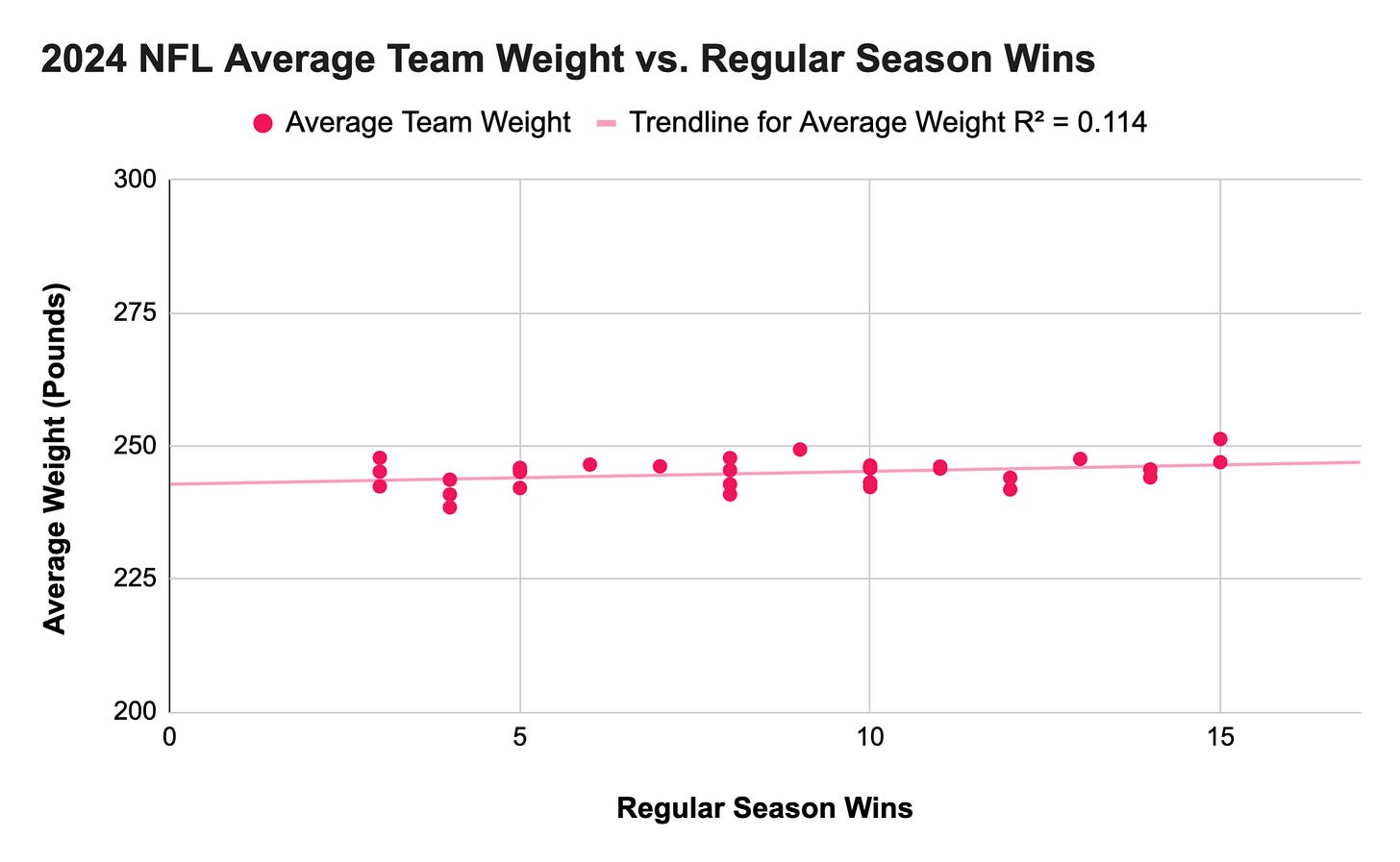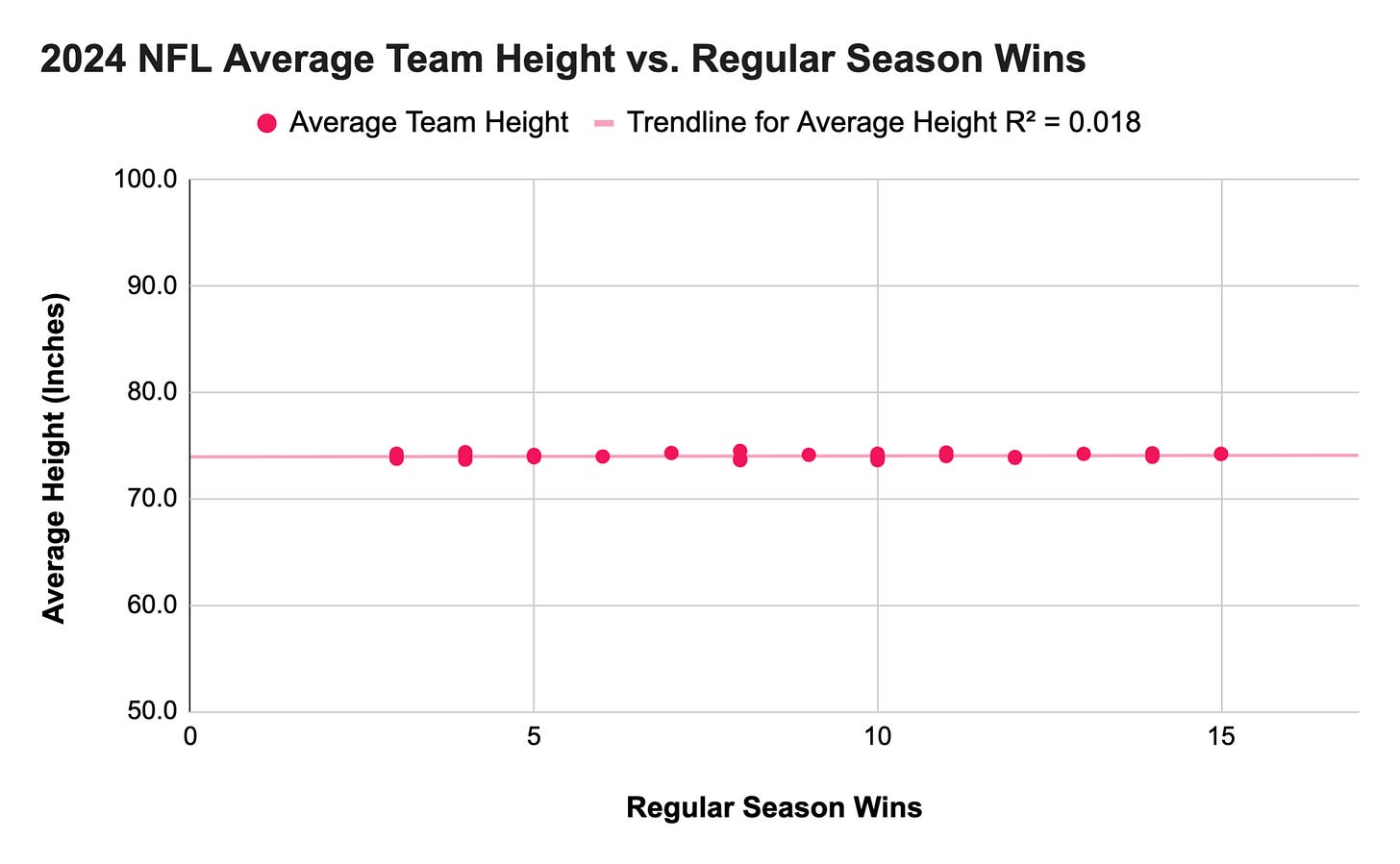Recess #4: It Takes Mass to Move Mass?
On the eve of Super Bowl LIX, we ask important questions about what makes a good football team
If you’ve watched a modern NFL game, you’ve probably asked yourself the question: “Shouldn’t a team assemble the largest group of absolutely enormous players on offense, hand the ball off, and just bulldoze the other team’s defense?” To be honest, it’s a great question, and if the emergent success of the Eagles’ “Tush Push” is any proof, maybe it’s a question that has an affirmative answer. I’ve asked myself this question many times, especially when I was looking to pass the time on Sundays during the dregs of my fantasy season once it was clear that I wouldn’t be making the playoffs en route to a last place finish.
Of course, to truly test this hypothesis would require full commitment by a team to create a new roster structure and offensive scheme the likes of which doesn’t exist. However, I ended up wanting to see if there exists any correlation between the weight of an NFL team and their success on the field before such a strategic shift (and to do so with a sample size of just one season and draw unassailable conclusions). To do this, I went through the process of combining all the NFL rosters from the 2024 season into a single spreadsheet. It was a pain and I’m shocked that this type of database didn’t exist already, so here is a link to it if you want it for your own purposes.
The actual process of plotting this data provided the first insight of the endeavor: NFL teams have huge variations in their official roster size at this point in the season— who knew (apart from people who pay attention)! This meant I couldn’t use total weight because player quantity per team varied too much, so I ended up using the average weight per player as the weight metric, and measuring success based on regular season wins this year:

As it turns out, the average weight of the players on an NFL team has practically zero correlation with their regular season success… at least when all the teams in the league have such similar rosters. I was shocked to see such a narrow band of average team weights, with the Detroit Lions topping out at 251 lbs/player and the Las Vegas Raiders rounding out the bottom with 238 lbs/player. Given the huge variety of positions, players, coaching styles, and scouting preferences, I would have guessed there’d be far more variation from team to team, even if there was still no correlation to wins. If anything it highlights the lack of major creativity and strategy differences between the teams. They all seem to be playing the game in a similar way, which makes last week’s article about how to establish a “meta” even more relevant now!
Investigating Meta, but Not in a Meta Way
The 2024 League of Legends (“League”) World Championship wrapped up in November as one of the most watched esports events of all time, peaking at 50 million concurrent viewers globally. In response, Riot Games, the creator of League, did what any professional sports governance body would obviously do, and made sweeping changes to the game itself. Not on…
So maybe today the weight of a team has no impact on their success, but what about height? Maybe I was thinking about the “size” of a player incorrectly, and you really just want tall guys, not heavy guys…

Nope! Once again, the average height of your NFL team has practically zero impact on winning (or losing). Whether you are the Indianapolis Colts with the tallest average player at 6’ 2.5” or the Cardinals down at 6’ 1.6” your chances of hoisting a trophy are effectively the same. However, I do wonder if you dug into individual position groups like Quarterback or Wide Receiver if there might be a hint of correlation here! I also wonder if the same is true for weight with O-line and D-line positions. Perhaps an article for another day…
But ok, so average height and weight don’t really matter, but surely the average age of the players on a team must dictate their success in some way?
Wrong. In fact, there might literally be zero correlation between the average age of a team and their success. Perhaps more youthful players provide enough explosiveness and injury-prevention capability to balance out the benefits of experience in the league, at least in the regular season. I would love to plot team outcomes against average age for the playoffs. Despite rookie Jayden Daniels carrying his team to the NFC championship this year, it does anecdotally seem that more experienced teams do better in the playoffs.
So what are the key takeaways here? Well, for starters, it seems like no basic physical characteristic averaged across the entirety of an NFL roster influences performance. However, that is only true in the current meta of the NFL, which highlights the second key takeaway. Apparently every single team is trying and succeeding in constructing a nearly identical roster from a size and age perspective as the rest of the league. There appears to be a large reluctance to field a team that appears very different from the rest, perhaps as a risk mitigation effort for coaches and managers.
The third key takeaway? NFL players are absolutely ginormous— and for fun, I wanted to highlight that the heaviest NFL Player (Trent Brown, 380 lbs), is over twice as heavy as the lightest (KaVontae Turpin, 153 lbs). Once again, this stat alone gives me hope that the mega-man only roster could work…
P.S. If you’re looking for an incredible visualization of the height and weight of NFL players throughout history, this animation by Noah Veltman is incredible. It’s quite striking how much you can tell the game has changed (and become higher quality) simply by the average athlete’s body type!
Anyways, there’s the bell!







